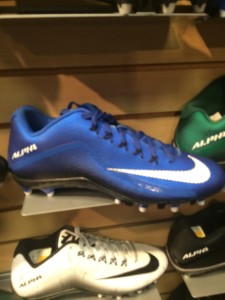Football Cleats
Fitting, Care and Foot Health

School is starting here soon and that means football season is coming. A well-fitting pair of football cleats is one of the most important pieces of equipment you can purchase as a football player. Cleats help you keep your footing, help you propel as you sprint and allow you to quickly stop, cut and change directions on the playing field.
Here are a few steps for fitting and caring for your cleats and your feet so that you don’t develop problems that might require the attention of an athletic trainer or doctor.
Things You’ll Need
Newspaper
Petroleum jelly
Step 1
Ensure that your football cleats are the appropriate size. Poorly-fitted football cleats can lead to blisters, sores and other foot and ankle injuries. Your shoes should fit snugly in the heels with plenty of room in the toes. Your longest toe should be 1/2 inch from the tip of your shoe.
Step 2
Use petroleum jelly on portions of your feet that may be susceptible to blisters and sores from friction. Apply a thin layer of petroleum jelly to your toes as well as your heels to help reduce friction.
Step 3
Walk around in your new football cleats in your house, backyard or a park. This can help your feet get used to your new cleats.
Step 4
Gradually introduce your new football cleats to practices. Wear your new cleats for a few hours each practice until you are comfortably able to wear them all practice.
Step 5
Stuff your cleats with newspaper after each use. This can help to stretch the shoe and keep the shape of your shoe.
Tips
Always try shoes on prior to purchase. Football cleats should fit relatively comfortably at purchase. Avoid buying shoes that seem uncomfortable from the minute you try them on.
To prevent foot and ankle injuries, replace your football cleats when they become worn or damaged.
Warnings
If you suspect a foot or ankle injury, contact us at (402) 315-4406 to schedule an appointment.
*These comments are informational only and should not be construed as medical advice, which can only be provided by an examining doctor.





Call Us Today: 402.315.4406